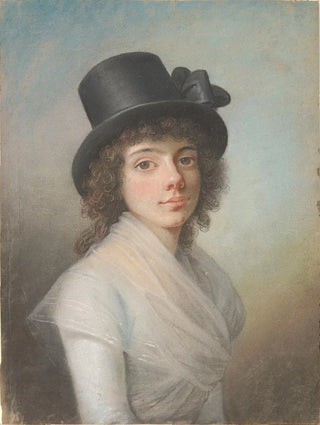Art print | Portrait of Petronella Cornelia Römeling - Jens Juel


View from behind

Frame (optional)
The "Portrait of Petronella Cornelia Römeling" by Jens Juel is a masterpiece that transcends the simple frame of painting to become a true window into the human soul. Created at the end of the 18th century, this artwork reflects an era when portraiture held significant social and cultural importance. The figure of Petronella, captured with extraordinary delicacy, evokes not only physical beauty but also a psychological depth that invites viewers to ponder the personality of her subject. Every brushstroke seems to tell a story, that of a woman of her time, while echoing universal concerns that still resonate today.
Style and uniqueness of the work
Jens Juel's style is characterized by a realistic and intimate approach, giving his subjects a palpable presence. In this art print, light plays a crucial role, illuminating Petronella's face with an almost ethereal softness. The details of her attire, meticulously rendered, reveal a keen sense of observation and impressive technical mastery. The color palette, subtly nuanced, enhances the harmony of the composition while adding warmth that invites contemplation. Juel manages to capture not only the external appearance of his model but also an inner essence, making this art print highly distinctive. Petronella's gaze, both gentle and penetrating, seems to engage in a silent conversation with the viewer, creating an emotional connection that transcends time.
The artist and his influence
Jens Juel, an emblematic figure of Danish painting, established himself as one of the most respected portrait artists of his time. His training in France and immersion in European artistic currents allowed him to develop a unique style, blending tradition and innovation. Juel had a significant influence on his contemporaries and contributed to the evolution of portraiture in Scandinavia, placing the model at the center of a rich and complex visual narrative. His work paved the way for many artists who sought to explore the psychology of characters through increasingly nuanced representations.

Matte finish

View from behind

Frame (optional)
The "Portrait of Petronella Cornelia Römeling" by Jens Juel is a masterpiece that transcends the simple frame of painting to become a true window into the human soul. Created at the end of the 18th century, this artwork reflects an era when portraiture held significant social and cultural importance. The figure of Petronella, captured with extraordinary delicacy, evokes not only physical beauty but also a psychological depth that invites viewers to ponder the personality of her subject. Every brushstroke seems to tell a story, that of a woman of her time, while echoing universal concerns that still resonate today.
Style and uniqueness of the work
Jens Juel's style is characterized by a realistic and intimate approach, giving his subjects a palpable presence. In this art print, light plays a crucial role, illuminating Petronella's face with an almost ethereal softness. The details of her attire, meticulously rendered, reveal a keen sense of observation and impressive technical mastery. The color palette, subtly nuanced, enhances the harmony of the composition while adding warmth that invites contemplation. Juel manages to capture not only the external appearance of his model but also an inner essence, making this art print highly distinctive. Petronella's gaze, both gentle and penetrating, seems to engage in a silent conversation with the viewer, creating an emotional connection that transcends time.
The artist and his influence
Jens Juel, an emblematic figure of Danish painting, established himself as one of the most respected portrait artists of his time. His training in France and immersion in European artistic currents allowed him to develop a unique style, blending tradition and innovation. Juel had a significant influence on his contemporaries and contributed to the evolution of portraiture in Scandinavia, placing the model at the center of a rich and complex visual narrative. His work paved the way for many artists who sought to explore the psychology of characters through increasingly nuanced representations.






